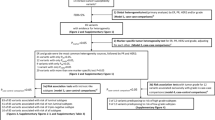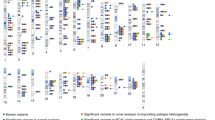Abstract
E-cadherin is involved in cell–cell adhesion and epithelial-to-mesenchymal transitions. In cancers, loss or inactivation of E-cadherin is associated with epithelial cell proliferation and invasion. Here, we sought to determine, if risk associations for 18 breast cancer susceptibility single nucleotide polymorphisms (SNPs) differed by E-cadherin tumor tissue expression in the Polish Breast Cancer Study (PBCS), using data on 1,347 invasive breast cancer cases and 2,366 controls. E-cadherin expression (low/high) was assessed using immunohistochemical staining of tumor tissue microarrays. Replication data on 2,006 cases and 6,714 controls from the Study of Epidemiology and Risk Factors in Cancer Heredity was used to follow-up promising findings from PBCS. In PBCS, we found the rs11249433 SNP at the 1p11.2 locus to be more strongly associated with risk of E-cadherin low tumors (OR = 1.30, 95 % CI = 1.08–1.56) than with E-cadherin high tumors [OR = 1.06, 95 % CI = 0.95–1.18; case-only p-heterogeneity (p-het) = 0.05]. Findings in PBCS for rs11249433 were replicated in SEARCH. Combined analyses of the two datasets for SNP rs11249433 revealed significant heterogeneity by E-cadherin expression (combined case-only p-het = 0.004). Further, among carriers of rs11249433, the highest risk was seen for E-cadherin low tumors that were ER-positive and of lobular histology. Our results in two independent data sets suggest that rs11249433, which is located between the NOTCH2 and FCGR1B genes within the 1p11.2 locus, is more strongly associated with risk of breast tumors with low or absent E-cadherin expression, and suggest that evaluation of E-cadherin tumor tissue expression may be useful in clarifying breast cancer risk factor associations.

Similar content being viewed by others
References
Mavaddat N, Antoniou AC, Easton DF, Garcia-Closas M (2010) Genetic susceptibility to breast cancer. Mol Oncol 4:174–191
Zhang B, Beeghly-Fadiel A, Long J, Zheng W (2011) Genetic variants associated with breast-cancer risk: comprehensive research synopsis, meta-analysis, and epidemiological evidence. Lancet Oncol 12:477–488
Broeks A, Schmidt MK, Sherman ME et al (2011) Low penetrance breast cancer susceptibility loci are associated with specific breast tumor subtypes: findings from the Breast Cancer Association Consortium. Hum Mol Genet 20:3289–3303
Yang XR, Sherman ME, Rimm DL et al (2007) Differences in risk factors for breast cancer molecular subtypes in a population-based study. Cancer Epidemiol Biomarkers Prev 16:439–443
Perl AK, Wilgenbus P, Dahl U, Semb H, Christofori G (1998) A causal role for E-cadherin in the transition from adenoma to carcinoma. Nature 392:190–193
Meiners S, Brinkmann V, Naundorf H, Birchmeier W (1998) Role of morphogenetic factors in metastasis of mammary carcinoma cells. Oncogene 16:9–20
Acs G, Lawton TJ, Rebbeck TR, LiVolsi VA, Zhang PJ (2001) Differential expression of E-cadherin in lobular and ductal neoplasms of the breast and its biologic and diagnostic implications. Am J Clin Pathol 115:85–98
Garcia-Closas M, Brinton LA, Lissowska J et al (2006) Established breast cancer risk factors by clinically important tumour characteristics. Br J Cancer 95:123–129
Yang XR, Pfeiffer RM, Garcia-Closas M et al (2007) Hormonal markers in breast cancer: coexpression, relationship with pathologic characteristics, and risk factor associations in a population-based study. Cancer Res 67:10608–10617
Udler MS, Azzato EM, Healey CS et al (2009) Common germline polymorphisms in COMT, CYP19A1, ESR1, PGR, SULT1E1 and STS and survival after a diagnosis of breast cancer. Int J Cancer 125:2687–2696
Szasz AM, Nemeth Z, Gyorffy B et al (2011) Identification of a claudin-4 and E-cadherin score to predict prognosis in breast cancer. Cancer Sci 102:2248–2254
Guler G, Balci S, Costinean S et al (2012) Stem cell-related markers in primary breast cancers and associated metastatic lesions. Mod Pathol 25:949–955
Ali HR, Dawson SJ, Blows FM, Provenzano E, Pharoah PD, Caldas C (2011) Cancer stem cell markers in breast cancer: pathological, clinical and prognostic significance. Breast Cancer Res 13:R118
Azzato EM, Pharoah PD, Harrington P et al (2010) A genome-wide association study of prognosis in breast cancer. Cancer Epidemiol Biomarkers Prev 19:1140–1143
Figueroa JD, Garcia-Closas M, Humphreys M et al (2011) Associations of common variants at 1p11.2 and 14q24.1 (RAD51L1) with breast cancer risk and heterogeneity by tumor subtype: findings from the Breast Cancer Association Consortium. Hum Mol Genet 20:4693–4706
Hein R, Maranian M, Hopper JL et al (2012) Comparison of 6q25 breast cancer hits from Asian and European Genome Wide Association Studies in the Breast Cancer Association Consortium (BCAC). PLoS ONE 7:e42380
Easton DF, Pooley KA, Dunning AM et al (2007) Genome-wide association study identifies novel breast cancer susceptibility loci. Nature 447:1087–1093
Colleoni M, Russo L, Dellapasqua S (2011) Adjuvant therapies for special types of breast cancer. Breast 20(Suppl 3):S153–S157
Michailidou K, Hall P, Gonzalez-Neira A, et al. (2013) Large-scale genotyping identifies 41 new loci associated with breast cancer risk. Nat Genet. 45: 353–361, 61e1-2
Husing A, Canzian F, Beckmann L et al (2012) Prediction of breast cancer risk by genetic risk factors, overall and by hormone receptor status. J Med Genet 49:601–608
Thomas G, Jacobs KB, Kraft P et al (2009) A multistage genome-wide association study in breast cancer identifies two new risk alleles at 1p11.2 and 14q24.1 (RAD51L1). Nat Genet 41:579–584
Ward LD, Kellis M (2012) HaploReg: a resource for exploring chromatin states, conservation, and regulatory motif alterations within sets of genetically linked variants. Nucleic Acids Res 40:D930–D934
Fu YP, Edvardsen H, Kaushiva A et al (2010) NOTCH2 in breast cancer: association of SNP rs11249433 with gene expression in ER-positive breast tumors without TP53 mutations. Mol Cancer 9:113
Bouras T, Pal B, Vaillant F et al (2008) Notch signaling regulates mammary stem cell function and luminal cell-fate commitment. Cell Stem Cell 3:429–441
Timmerman LA, Grego-Bessa J, Raya A et al (2004) Notch promotes epithelial-mesenchymal transition during cardiac development and oncogenic transformation. Genes Dev 18:99–115
O’Connor IF, Shembekar MV, Shousha S (1998) Breast carcinoma developing in patients on hormone replacement therapy: a histological and immunohistological study. J Clin Pathol 51:935–938
Goldstein NS, Kestin LL, Vicini FA (2001) Clinicopathologic implications of E-cadherin reactivity in patients with lobular carcinoma in situ of the breast. Cancer 92:738–747
Rakha EA, Abd El Rehim D, Pinder SE, Lewis SA, Ellis IO (2005) E-cadherin expression in invasive non-lobular carcinoma of the breast and its prognostic significance. Histopathology 46:685–693
Acknowledgments
We thank Drs Beata Peplonska and Neonila Szeszenia-Dabrowska of the Nofer Institute of Occupational Medicine (Lodz, Poland), Witold Zatonski of the Department of Cancer Epidemiology and Prevention, the M Sklodowska-Curie Cancer Center and Institute of Oncology (Warsaw, Poland), and Pei Chao and Michael Stagner from Information Management Services (Silver Spring, MD, USA), for their valuable contributions to the study. We also thank the participants, physicians, pathologists, nurses, and interviewers from participating centers in Poland for their efforts during field-work.
Conflict of interest
The authors declare that they have no conflict of interest.
Funding
This research was supported by the Intramural Research Programs of the Division of Cancer Epidemiology and Genetics and Center for Cancer Research of the National Cancer Institute. M. Garcias-Closas is funded by the Breakthrough Breast Cancer Centre and the Institute of Cancer Research, London, UK. We acknowledge NHS funding to the Royal Marsden/ICR NIHR Biomedical Research Centre.
Author information
Authors and Affiliations
Corresponding author
Electronic supplementary material
Below is the link to the electronic supplementary material.
Rights and permissions
About this article
Cite this article
Horne, H.N., Sherman, M.E., Garcia-Closas, M. et al. Breast cancer susceptibility risk associations and heterogeneity by E-cadherin tumor tissue expression. Breast Cancer Res Treat 143, 181–187 (2014). https://doi.org/10.1007/s10549-013-2771-z
Received:
Accepted:
Published:
Issue Date:
DOI: https://doi.org/10.1007/s10549-013-2771-z




